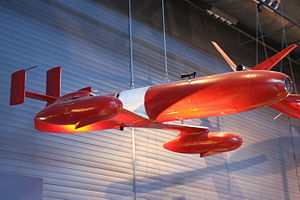- Curtiss KD2C Skeet
-
KD2C Skeet Curtiss-Wright KD2C Skeet on display at the Steven F. Udvar-Hazy Center Role Target drone National origin United States Manufacturer Curtiss-Wright The Curtiss-Wright KD2C Skeet was an American target drone produced by Curtiss-Wright that began development in 1945.
"The Skeet was a pulsejet-powered, air-launched expendable drone designed for the U.S. Navy for fleet gunnery training. It could use a 36-centimeter (14-inch) McDonnell J-11, McDonnell J-9 or Continental pulsejet engine. Control was provided by two axis elevators and ailerons through a radio receiver and gyro stabilizing system. The drone could fly for 30 minutes and reach 540 kilometers (335 miles) per hour."
"The Skeet project began in August 1945 and produced its first experimental model was produced in 1947. However, the Skeet's unusual internally-mounted pulsejet proved unsatisfactory because it produced low speed and high fuel consumption in both wind tunnel and flight tests at the Navy's Missile Test Center at Point Mugu, California. The project was cancelled in 1949."
Specifications (KD2C-2)
Data from Placard at Udvar-Hazy
General characteristics
- Crew: None
- Length: 17 ft (5.2 m)
- Wingspan: 10 ft 6 in (3.20 m)
- Gross weight: 1,258 lb (571 kg)
- Powerplant: 1 × 14-inch (356 mm) pulsejet 282–330 pounds-force (1,254–1,468 N)
Performance
- Maximum speed: 335 mph (539 km/h; 291 kn)
- Endurance: 30 minutes
References
- This article contains material that originally came from the placard at the Steven F. Udvar-Hazy Center.
External links
USN drone and missile designations 1946–1947 Anti-aircraft missiles Martin: KAM · Naval Aircraft Factory: KAN • KA2N • KA3N · Fairchild: KAQ · Sperry: KAS · Consolidated-Vultee: KAYDrones KDB • KD2B
KDC • KD2C • KD3C
GlobeKDG • KD2G • KD3G • KD4G • KD5G • KD6G
RadioplaneKDR • KD2R • (KD3R not assigned) • XKD4R
KDT
Ground-attack missiles Willys-OverlandKGWAnti-ship missiles Research missiles Lists relating to aviation General Aircraft (manufacturers) · Aircraft engines (manufacturers) · Airlines (defunct) · Airports · Civil authorities · Museums · Registration prefixes · Rotorcraft (manufacturers) · TimelineMilitary Accidents/incidents Records Categories:- United States special-purpose aircraft 1940–1949
- Unmanned aerial vehicles of the United States
- Pulsejet-powered aircraft
- Curtiss aircraft
- Single-engined jets
Wikimedia Foundation. 2010.

